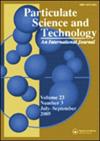高磁响应性葡萄糖固定化荧光聚合物颗粒的制备
IF 1.5
4区 工程技术
Q3 ENGINEERING, CHEMICAL
引用次数: 0
摘要
摘要聚糖固定化颗粒可用于多种生物医学应用,如蛋白质、病毒和细菌的检测、分离和纯化,它们可以特异性地与聚糖部分结合。快速准确地检测这些成分的一种策略是将这些成分与颗粒表面结合后磁性收集颗粒。我们制造了由磁芯和薄聚合物壳组成的核壳粒子。壳与荧光染料结合,葡萄糖分子固定在其表面。我们选择Fe3O4粒子作为磁芯。考虑到其对环境的低影响,我们采用无皂乳液聚合来形成聚合物外壳。因此,甲基丙烯酸甲酯在Fe3O4颗粒、辛基-β-d-葡萄糖吡喃苷和罗丹明B存在下聚合,在Fe3O4颗粒上生成葡萄糖覆盖的荧光PMMA薄壳。所得粒子的饱和磁化强度为~ 53 emu/g。本研究的新颖之处在于,可以用一种环保的方法合成具有优异磁性能的葡萄糖固定聚合物颗粒,该颗粒可以在5 s内用磁铁收集。关键词:fe3o4糖壳颗粒无皂乳液聚合披露声明作者未报告潜在利益冲突。本研究由JSPS KAKENHI资助,资助号为21K04764, AMED资助号为JP21lm0203010和JP22ym0126803,以及茨城市大学特别促进研究资助。本文章由计算机程序翻译,如有差异,请以英文原文为准。
Fabrication of glucose-immobilizing fluorescent polymer particles with high magnetic responsiveness
AbstractGlycan-immobilizing particles are useful for a wide variety of biomedical applications, such as the detection, separation, and purification of proteins, viruses, and bacteria, which can be specifically bound by the glycan moieties. One strategy for the quick and accurate detection of these components is to collect the particles magnetically after binding the components to the particle surface. We fabricated core–shell particles composed of a magnetic core and a thin polymer shell. The shell was incorporated with a fluorescent dye with glucose molecules immobilized on its surface. As the magnetic core, we selected Fe3O4 particles. Taking into consideration its low environmental impact, we adopted soap-free emulsion polymerization to form the polymer shell. Thus, methyl methacrylate was polymerized in the presence of Fe3O4 particles, octyl-β-d-glucopyranoside, and rhodamine B to generate a glucose-capped fluorescent PMMA thin shell on the Fe3O4 particles. The resulting particles exhibited a saturation magnetization of ∼53 emu/g. The novelty of this research is that glucose-immobilized polymer particles with excellent magnetic properties that can be collected in 5 s using a magnet can be synthesized with an environmentally friendly method.Keywords: Fe3O4glucosecore–shell particlesoap-free emulsion polymerization Disclosure statementNo potential conflict of interest was reported by the author(s).Additional informationFundingThis research was supported by JSPS KAKENHI under Grant Number 21K04764, AMED under Grant Numbers JP21lm0203010 and JP22ym0126803, and an Ibaraki University Grant for Specially Promoted Research.
求助全文
通过发布文献求助,成功后即可免费获取论文全文。
去求助
来源期刊

Particulate Science and Technology
工程技术-工程:化工
CiteScore
4.40
自引率
4.00%
发文量
86
审稿时长
12 months
期刊介绍:
Particulate Science and Technology, an interdisciplinary journal, publishes papers on both fundamental and applied science and technology related to particles and particle systems in size scales from nanometers to millimeters. The journal''s primary focus is to report emerging technologies and advances in different fields of engineering, energy, biomaterials, and pharmaceutical science involving particles, and to bring institutional researchers closer to professionals in industries.
Particulate Science and Technology invites articles reporting original contributions and review papers, in particular critical reviews, that are relevant and timely to the emerging and growing fields of particle and powder technology.
 求助内容:
求助内容: 应助结果提醒方式:
应助结果提醒方式:


